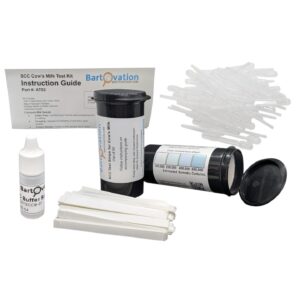Subclinical mastitis (SCM) is a hidden but costly threat to dairy herds, affecting milk quality and yield without obvious symptoms. Because it lacks visible signs like swelling, abnormal milk, or pain, it’s critical to have sensitive, reliable testing methods to detect the issue early. Several screening tools exist on the market, ranging from basic field tests to advanced kits offering quantitative data. Below is a breakdown of the most common testing options.
1. Dr. Naylor* Mastitis Test: pH and Visual Changes
The Dr. Naylor* Mastitis Test is a simple, field-based test that detects changes in milk pH and visual abnormalities. When mastitis occurs, the infection can alter the milk’s acidity, which this test identifies. It also includes a small black detection area to spot flakes or inconsistencies in the milk.
Limitations:
- No somatic cell count (SCC) measurement: This test does not quantify SCC, the primary indicator of subclinical mastitis.
- Lacks quantitative pH values: It simply detects a shift in acidity rather than providing specific data.
- Best for detecting clinical cases: Due to its limited sensitivity, it is more effective at identifying advanced mastitis cases—those likely accompanied by visible signs and very high SCCs (in the millions).
In essence, this test is not well-suited for early intervention or detecting subclinical infections.
2. California Mastitis Test (CMT): Gel Formation Based on SCC
The California Mastitis Test (CMT) is a widely used method where milk is mixed with a reagent in a paddle. The resulting gel formation corresponds to the SCC level—thicker gels typically indicate a higher cell count.
Strengths:
- Easy to use
- Can give a rough SCC estimate (seasoned users may gauge levels between 700,000–1,000,000 cells/mL)
Limitations:
- Lacks sensitivity for early detection: At the point where CMT gives a noticeable result, the infection is already well underway.
- No precise SCC value: It’s a subjective, qualitative test.
- Affected by many variables: Age, lactation number, milk production level, and even seasonality can impact SCC numbers.
This makes the CMT better suited for confirming suspected clinical cases rather than guiding preventative action.
3. Bartovation SCC Test: Quantitative, Early Detection Tool
Bartovation’s SCC test offers a major advancement in mastitis screening by providing numerical readings for somatic cell count, detecting cases well before they become clinical and when prevention is still an option.
Strengths:
- Quantifies SCC: Unlike pH-based or gel-based tests, it gives specific results across the testing range.
- Detects low SCC levels: Can identify samples below 100,000 cells/mL, enabling very early detection.
- Ideal for subclinical detection: Alerts farmers before SCC rises above 200,000–300,000 cells/mL—recognized thresholds for SCM.
- Works with both quarter and composite samples
- Complements monthly DHIA screenings: Great for monitoring high-risk cows (fresh, recently treated, or flagged by DHIA) between scheduled tests.
Limitations:
- Waiting time for results: Although this test only takes one minute of hands on time to run, there is a 15 minute waiting time before you can take the reading
- Affected by many variables: Age, lactation number, milk production level, and even seasonality can impact SCC numbers.
This test supports proactive herd management by helping farmers maintain low bulk tank SCCs, thus preserving milk quality and maximizing incentives from cooperatives.
4. Bartovation LDH Test: Detect Damage Before SCC Rises
For even earlier detection, Bartovation offers a Milk Mastitis LDH Test that identifies lactate dehydrogenase (LDH)—an enzyme released when udder tissue becomes damaged during infection.
Strengths:
- LDH rises before SCC: This makes it a valuable early-warning signal, often preceding changes in SCC.
- Not influenced by as many variables: LDH tests offer more consistency compared to SCC-based methods.
- Fast, affordable, and stable: LDH is stable in milk, making this test practical for both quarter samples and bulk tank testing (with some limitations).
Limitations:
- Best for quarter testing: Infection probability on the chart is quarter specific, so, although it can give you a composite LDH number that would be less actionable to farmers than a composite SCC measurement.
- Bulk Tank Testing: LDH can be reliably tested in freshly filled tanks. However, since this test doesn’t measure SCC and is designed for quarter-level diagnostics, bulk tank results should be interpreted with caution and focus only on LDH levels—not infection probabilities.
Summary: Choosing the Right Tool
| Test Type | Measures | Sensitivity | Quantitative | Best Use Case |
|---|---|---|---|---|
| Dr. Naylor* | pH, visual cues | Low (clinical cases) | No | Confirming obvious, severe infections |
| CMT | SCC (subjective) | Medium (700K–1M SCC) | No | Quick on-farm screening of suspect quarters |
| Bartovation SCC Test | SCC (numerical) | High (detects <100K SCC) | Yes | Early detection, herd monitoring |
| Bartovation LDH Test | LDH enzyme | Very High (pre-SCC changes) | Yes | Ultra-early detection, even before SCC spikes |
Final Thoughts
Detecting subclinical mastitis early is essential to protecting animal health, milk quality, and farm profitability. While traditional methods like pH tests and CMT are inexpensive and offer quick results, they often fall short in identifying problems early enough for effective intervention. Bartovation’s SCC and LDH tests provide dairy farmers with reliable, quantitative tools for early detection, supporting more informed treatment decisions and better long-term outcomes.
*DR. NAYLOR is a registered trademark of H.W. NAYLOR COMPANY, INC in Morris, New York. These Bartovation products are neither endorsed, nor sponsored by or affiliated with H.W. NAYLOR COMPANY, INC.


![AT02V50 MAIN 1 Cow Milk LDH Test Strips for Mastitis [Vial of 50 Tests]](https://bartovation.com/wp-content/uploads/2023/12/AT02V50-MAIN-1-300x300.png)
![BHB-main-image Milk Ketone Test for BHB in Cow Milk [Vial of 50 Strips]](https://bartovation.com/wp-content/uploads/2023/09/BHB-main-image-1-300x300.png)